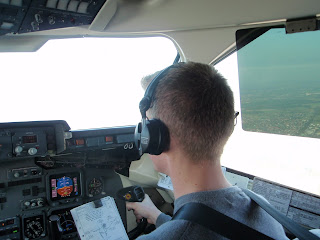
The day started as a normal one. I woke up at 10h30 local time, and arrived in the crewroom at 12h30, which is 2hrs before the start of the first flight. This gives me the time to prepare the flight at ease (check the weather, airport status, routing, ...). 30 minutes later the Captain arrived as well, and we had a little chit-chat about the flights (and some other non-related stuff as well ofcourse! ;-) ). 50 minutes before the engine start-up, we passed through security (yep, we have to do this as well!) and entered the van that will take us to the airplane.

At Brussels Airlines, Captains have to do the external walkaround (check that the airplane is airworthy), and First Officers have to prepare the cockpit. Once this is done and the boarding is complete, we can start the engines.

For the 1st flight to HAM, I was the Pilot Flying (PF), and the Captain was the Pilot Non Flying (PNF). To summarise, the primary task of the PF is to control the aircraft's horizontal and vertical flightpath. The task of the PNF is to communicate with Air Traffic Control, fill in the flightplan, do fuel checks and to do the checklists. We take-off from Brussel, and turn right towards the North. When we were abeam Antwerp I asked to put the autopilot on. This gives me more resources to manage the rest of the climb as efficient as possible.
From Antwerp we passed via Rotterdam, Amsterdam, Groningen and Bremen to Hamburg. In Hamburg we had to do some extra miles due to the wind. We had a Westerly wind, which means that we have to land in a Westerly direction, as you can see below.

An airplane always has a speed relative to the airmass it's flying in. However, if that airmass is moving as well, the airplane's speed relative to the ground will differ from it's speed relative to the air. For example, if we are landing at a speed of 130kts, with a headwind of 10kts, the relative groundspeed will only be 120 kts. This shortens the landing distance required (safety!), but is also better for the brakes.

Anyway, after a succesful landing we taxi to our parking position (52). We shut down the engines in sequence, open the doors and the bus arrives to pick up the passengers.

The Captain goes outside again to do his walkaround, and I prepare the cockpit again for the next homebound departure. After some minutes the cockpit is ready again, and the Captain comes back inside. Today he's bringing some bad news along with him. He noticed that we had a birdstrike somewhere during the flight.



Birdstrikes happen often, and in general are not a great danger to airplanes. But today, we discuss about it and come to the conclusion that the bird went right through the core of the engine. Knowing this we can't just start the engines and leave. The Captain calls the operations department in Brussels. Our next flight is cancelled, and they will send 2 technicians to Hamburg with the next flight (with an airbus A319). 2 hrs later, the aircraft arrives. The technicians come to our airplane, and the cabin crew and passengers are going back to Brussels with the A319. This means that the Captain and me have some hours to spare in an empty airplane.

While the technicians are working on the engine, I go outside and take the time to make some pictures of the Jumbolino.

After 1,5 hrs the technicians tell us that the engine is fine. The bird indeed went through the core of the engine, but there is no damage. They'll close the engine again and after that we can do a ferry flight (empty airplane) back to Brussels!

One of the technicians is as old as I am (1990). He is in training, and would like to follow the flight from the jumpseat. The Captain is the PF for the way back. In cruise we share all of our knowledge and experiences. After seeing what they were doing with the engine, and the conversation, I can tell you that being a technician looks more difficult to me than being a pilot.

Anyway, We arrive in Brussels way behind schedule. The flight to BMA has already left with another airplane and crew. This means that our day is over, and the next day I'll be on reserve instead of returning from BMA and going to BUD.
After all I have to say that, unlike all of the other people, I enjoyed the day. It was very learnful and a good experience, knowing that one day this will happen to me as well when I am in command of the airplane. You can learn a lot from reading the manuals, but in reality there will always be more and unforeseen factors that will lead to taking the right decisions.









